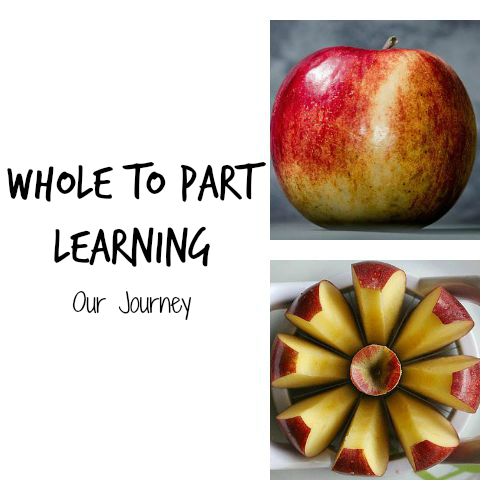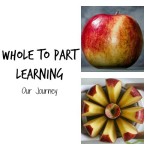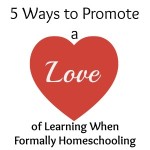 When I first started homeschooling, I didn’t know what I was doing. To top it off, it turned out that I had atypical learners on my hands. I thought learning things in a sequential manner was how things were supposed to work…until it didn’t. Since that time I have learned much and now whole-to-part learning is our new normal.
When I first started homeschooling, I didn’t know what I was doing. To top it off, it turned out that I had atypical learners on my hands. I thought learning things in a sequential manner was how things were supposed to work…until it didn’t. Since that time I have learned much and now whole-to-part learning is our new normal.
The first year I homeschooled my son was very frustrating for me. I thought my son would follow the standard sequential learning process that most kids seem to follow. It was not so. He grew to hate parts of school and I couldn’t figure him out. He surged ahead in reading and his phonics lagged behind. How could his phonics skills be behind his reading? I attempted to try to catch his phonics skills up to his reading level, but I was chasing a speeding train and not getting any closer. I gave up and let him continue with phonics at a slower pace.
By December of his Kindergarten year, we ceased formal schooling since he had pretty much completed what he should by that point. For the rest of the school year and the summer we unschooled him like we had done throughout the preschool years. But unschooling didn’t satisfy him. I took a step back and did some educational learning style tests with him in the Spring to try to figure him out. The testing helped me understand his learning process a bit more and it led me to approach schooling quite differently with him.
My son was a great lover of science. I had put together a dinosaur unit study for him for his Kindergarten year. Because it was a well-loved study, I decided to start making up studies in the same manner as the dinosaur study we did in his Kindergarten year. I switched to a math program that focused on word problems and the why of math rather than lots of rote practice. I had a happier kid. I also replaced phonics with a spelling program that focused on the rules of spelling, but my son still struggled. I wondered why this kid could read a 5th grade level book without much difficulty, but had difficulty distinguishing when a vowel was short or long. By 4th grade I dropped spelling all together. He turned out to be a natural speller that just needed a little more time to mature.
When my second child joined us for school, he showed similar behaviors. It is true about what they say about the firstborn. He was a guinea pig. When my other children started surging ahead in reading and lagging behind in phonics I took it in stride. It is now our normal.
That was many years ago. Homeschooling has taught me much! Since those first two years I have discovered that my kids tend to be whole-to-part learners. This means that they learn better by looking at the whole concept and then they can begin to understand the parts. One of my kids is a very strongly visual-spatial. My others are more balanced because they can learn in a sequential manner, but they tend to do well with whole-to-part methods.
How we make homeschooling work for non sequential learners?
Engagement
First and foremost, I must engage my children. Rote memorization detached from meaning was a useless waste of time. Rote practice without understanding the reasoning behind it was not very effective either. I tend to stay away from things that involve memorization as well as scripted programs. Textbooks are just a tool. They don’t have to be used in the standard manner. I like to use them as a jumping off point.
I put together studies filled with living books and activities to engage my kids. I do this for more content based subjects like history, geography, science, and Bible. I also use DVDs and Youtube videos heavily to help engage my kids. If they are engaged they learn very well.
Lighting the spark of interest is my goal. I love learning and I attempt to approach learning as a great adventure that we get to do together. I find it to be important to share material in a way that I find exciting. I know that if I am bored with the material, my kids would be as well. This doesn’t mean my kids don’t ever have to do something boring, but I try to keep boring to a minimum.
Longer school days
Longer school days have been a big part of our homeschooling journey. Sharing the length of our school days would get me tarred and feathered in some homeschooling circles, but it works for us. What do I mean by long? When my boys were younger, they would typically spend about 6 hours a day on school including PE. My current 2nd grader’s time isn’t that high because my time is divided between three kids at different levels, but she does typically spend longer than average.
Now my older kids spend about 8+ hours every school day, but that is split up between formal work, informal work, exercise, and educational videos. This gives us lots of time to pursue activities and electives – this is key. We don’t view school as something to get through so we could then go about real life. We view life as learning and learning as life. My children’s interests are sprinkled into our school days and we do pursue time-consuming ways to learn because homeschooling provides that luxury.
I asked my children if they would prefer to have shorter days where they get done the necessary work or if they like the longer days the way we do them. They prefer the longer days. Short is not sweet with them. Short would cut out the parts of school they like best.
So if your kid hates schoolwork, I’d like to suggest the possibility that instead of cutting back on school, you add to it. Sprinkle your child’s interests into your school days. If your child loves Minecraft, give him lots of time on Minecraft to build something that you learned about in history. If you child loves math, explore interesting math supplements and games to feed his passion. If your child loves to draw, incorporate drawing into many subjects. If you child wants to pursue an interest, make it just as important in your school day as math or reading. Don’t add in more formal work, but add in things your child would love. Let the definition of school be learning and not stuff-you-have-to-finish.
Realize learning can be accomplished through multiple levels.
While I’m sure there are kids out there who would fit into an all-in-one curriculum quite well, my children aren’t ones that would. My kids are working at many different grade levels across the various subjects. Not only that, but it is common for my kids to be working at several different levels within one subject.
Curriculum can still be used effectively when your child doesn’t fit in a box. With math my kids have been working at three different levels. My strongly visual-spatial learner needs to be working at multiple levels and my other kids have done very well with learning that way. I’ve used a standard curriculum and branched out to new concepts and ideas through things like living books and videos. Trailing behind was math fact practice. If my kid didn’t have multiplication facts mastered, it didn’t prevent the child from moving on in their main curriculum. We still practiced facts, but as something separate.
Using an all-in-one language arts program is out of window. I pick and choose something different for the language arts components to match my children’s skill levels in the various parts of language arts. My kids tend to prefer the variety that different resources provide anyway.
Easy is hard and hard is easy
For some kids easy things are hard and hard things are easy. This is especially true if you have a visual-spatial whole-to-parts kid.
I remember when my son was having difficulty with long division. He would get bored mid-problem and lose track of what was what and problems were often incorrect. Logic would say that the child needs more practice, right? I went the other direction. One day I gave him a huge long division problem and asked him if he could figure it out. His eyes lit up and he maintained interest in the problem until he solved it.
That moment something shifted in my thinking and instead of hanging around long division awhile making sure he was paying attention to detail, we started accelerating how fast we were going through his math curriculum. It was probably one of the best academic decisions I have made for that child. Conceptually, he needed to zoom ahead. He needed the harder stuff in order to stay focused, to be interested.
Novelty
We cover many different subjects and often use a wide variety of materials to approach each subject. If we are using a curriculum for a subject, I will often add to or supplement the curriculum with things I think my children would find interesting. This variety combined with loop scheduling makes every day different. This past school year I don’t think we have had two days where we approached the same subjects with the same materials. Sometimes we do math in the morning. Sometimes we do math in the afternoon. Sometimes we don’t have math at all. Sometimes math takes up most of the day, lol. It all works out in the end.
Because I use a lot of resources I list them all down in the summer and then go through my lists as open and go plans during the school year. It takes time, but my kids need it. I need novelty too.
Think outside the box
Think outside the box. Learning doesn’t have to involve or look like anything what you did in school or anything anyone else does in their homeschool. Use curriculum as a tool rather than something to control what your day-to-day learning is like. Most curriculum is designed for sequential learners and made by sequential learners. Whole-to-part learners need something different.
Engagement
Yes, I already listed engagement. I am listing it again because I find engagement is key for whole-to-part learners. They need their school work to be meaningful. If it is just something to learn because they are supposed to learn it, then it doesn’t go over well.
So I observe and tweak. If they hate something we are doing, I try to figure out how we can change it. Changing curriculum sometimes helps, but my budget doesn’t allow for much curriculum hopping. Sometimes I just need to use the curriculum in a different way. Sometimes it takes a little while to change a hated attitude towards a positive one, but I refuse to give up and let my child settle into a hatred of a subject. There isn’t a dependence on fun to keep their interest either. I’ve found that when the spark is lit they will eagerly do more “boring” activities as well as initiate learning activities outside of our school time.
This journey homeschooling has also been one of self-discovery. I have learned that I also do well with whole-to-part methods and have visual-spatial strengths. It wasn’t until college that I finally figured out how to study. I must have learned something during Kindergarten through high school, but I don’t remember much. Most of what I learned was done on my own as I pursued my interests. In college, there was quite a bit of memorizing to be done in my classes. In order for me to remember things, I had to make the material meaningful. I’d make a visual picture or a story about the things to remember. It would often take me 5-10 times longer to study than a good memorizer, but the information stuck. When the test was done, the knowledge was still there. So when picking and choosing ways to help my kids learn, I put it through a filter. Would I have enjoyed learning about the subject that way? If the answer is yes, then the likelihood that my children will be engaged is great.
I’m still learning how to teach my non-sequential learners and probably will be as long as I am their teacher. I am constantly adapting and thinking about different ways to teach them and often that means looking outside of the box. If you have whole to part learners I’d love to hear what works for you.







I have a visual spatial learner, who scored in the 90th percentile for it, on a test the public school gave him, when he was in first grade. I am attempting to homeschool him again , and he is now in fourth grade. What should I use for math? I have been using Khan Academy, however I am not sure it’s a good fit. I have read about the multiple intelligences theory, and I remembered the whole to parts learning piece.
We have a whole to part learner too and it was definitely a struggle for him to fit into public school’s part to whole philosophy. He still has trouble with spelling at 12 years old, he can visualize entire difficult words but can’t sound out. I like the idea of giving harder problems, not easier or more repetition, to master skills like long division! I will try that!